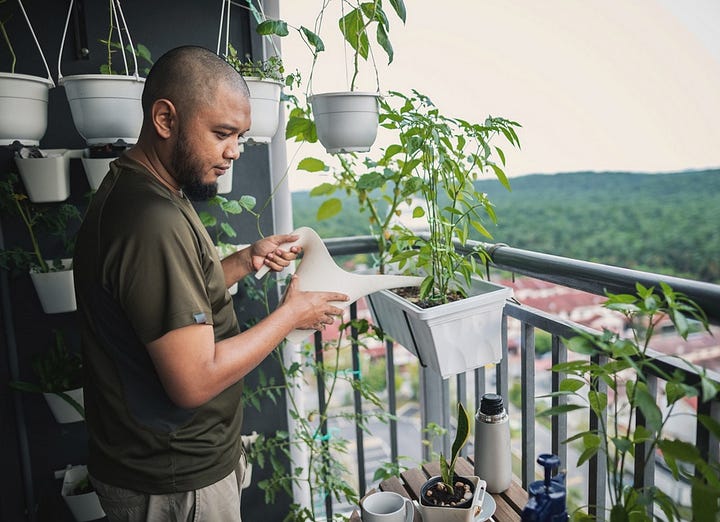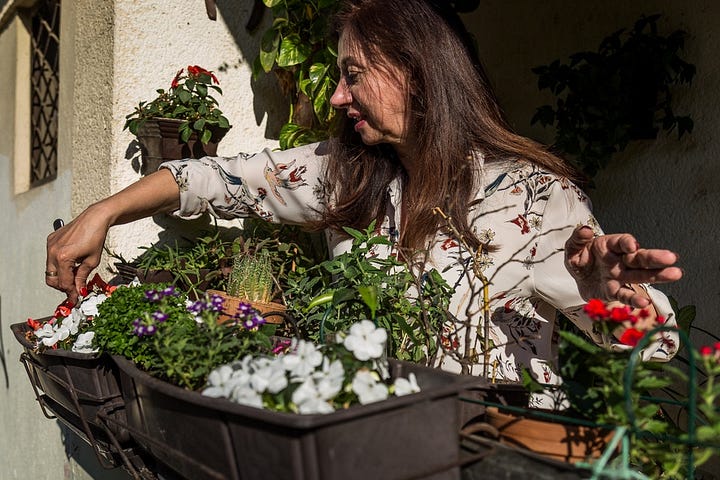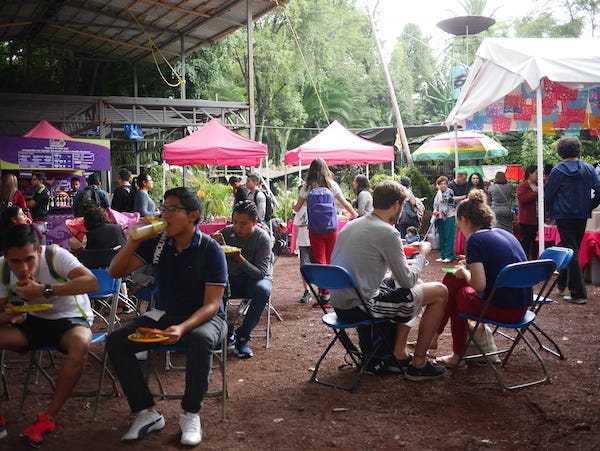Going Outside
G is for going outside in order to strengthen our microbiome. How much time does each of us spend engaging with the outdoors? How some microbes that aren't "probiotic" are just as important.
Last week I read somewhere, because it is like that, with so many words crossing our paths each day in the parade of content marching before our eyes, that humans in modern industrial societies spend 90% of their life indoors. This time is spent in buildings that are increasingly designed to keep and filter out whatever is out there, the natural world, as well as poor air quality. The context was around the health of our microbiome. In the same way, we need the microbes in our fresh or fermented foods, we need the microbes in the dirt and air to interact with our microbiome. Admittedly when I read a statistic, I immediately take stock of my own habits. My brain immediately comforted me, with oh, that is sad; how nice that you are not that person. After this-patting-myself-on-the-back moment, I asked myself, do I spend more than 10% of my day outside?
If I assume 12 hours of daylight awake time to get beyond 10%, I would need to be outside for more than 72 minutes a day. And I realize this number is only 5% of a full day. Lately (and let’s please blame the rainy winter so I have an excuse), I would be hard-pressed to reach 36 minutes a day. We live quite rurally, where I define myself as spending a good part of my day under the canopy of the sky, not in front of a computer. Without conscious effort on my part to get up, choose to go on a walk, tend the forest, or engage with our garden, this is not a reality. Anymore. I used to spend most of my time outdoors. We had gardens, orchards, and a passel of farm animals—goats, cows, ducks, horses, an adopted wild burro, and sometimes chickens, pigs, or sheep. When we could get away, it was to camp and hike. Don’t get me wrong, tromping through the landscape is still my favorite activity, but the business of the creative hustle demands my attention in much the same way as the dairy animals needed care—every day.
When I first began reading and writing about fermented foods, our homestead was still home to a menagerie of animals. I still made cheese from our dairy animals. The big news in the microbiome was that the microbes that live in and on us contain much more DNA, programming more metabolic pathways in us than our own human cells. Years later, this is accepted knowledge, and it is becoming clearer these little buddies control our quality of life in many ways—including what we crave if you remember this piece Christopher wrote.
It’s funny, but as our children grew and left and the lifestyle slowly changed to producing less food here, I would have easily thought any *health* changes would have been related to no longer having food as fresh or access to raw milk. It would never have occurred to me that in no longer midwifing baby goats or mucking out stalls was the point at which I was, in a sense, denying my immune system and microbiome of all important inputs.
Microbes are essential for our health. In his TEDx talk, Graham Rook describes how the immune system needs data inputs to function properly*. These inputs come from the natural world we interact with, like plants, soil, and animals. We coevolved, living in close proximity to nature, the dirt, and the plants and animals we tended. When we are born, or any animal is born, our first introduction to the world is the microbes that we will depend on for life. As we grow, our immune system and microbiota learn what to attack and what to ignore. However, our modern lifestyle has reduced our biodiversity, which can be “reinstalled” to some extent by going outside.
Despite our notions, our technology, and how we live, we can’t detach ourselves from nature. We are ecosystems, and many would argue these days, we are impoverished ecosystems. Our immune system's main directive is to manage and maintain our microbiome. As we move throughout our day and ingest and inhale microbes, our immune system samples the newcomers and decides who is a friend or foe. This is where simply going outside, or having pets in our lives, gives us more opportunity to provide that input our systems need so that we are less likely to suffer from malfunctioning, inflamed systems.
In this space, we are often talking about eating microbe-rich foods, so it is important to note that some of these microbes aren’t probiotics, in the way eating a probiotic-rich fermented food or taking a pill might be. In other words, they aren’t microbes that live in our microbiome but are contributing and helpful guests while they are visiting. For example, Professor Rook has researched one such “guest,” Mycobacterium vaccae, found near cows or just simply out in our yards, gardens, or parks. This bacterium was being studied as a cancer treatment; scientists didn’t find that it was helpful to combat cancer but saw positive changes in psychiatric disorders in patients. This led to studies in mice in which stressed mice were given a heat-killed preparation of Mycobacterium vaccae. The treatment reduced stress levels and inflammatory conditions in the gut. (The studies are linked at the end of this post.) At this point, however, they just know this works, and the molecular mechanisms causing the anti-inflammatory effects have not been identified.


I find all of this hopeful; we know that our microbiome is highly adaptable and constantly changing. It can change as quickly as a few days. I am not a healthcare professional, and I am also not suggesting it can heal in a few days, but our microbiomes are capable of continuously evolving. There are many studies that show small changes have big impacts. As we head into this next season, there are many lovely reasons for going outside, whether it is for smelling daffodils or tossing fall leaves in the air; either way, you will be engaging with microbes.
G is for Ginger. Ginger has, since ancient times, been a food that is good for the gut. Learn a little more about ginger and how to ferment it in this week’s paid subscriber post.
Additional rabbit holes
*In this talk, Professor Rook mentions a study where Amish children raised on small family farms had stronger innate immunity and fewer incidences of asthma as compared to Hudderite children raised on larger machine-operated farms. I found that fascinating and located the study. It is an easier layperson read than some.
Mycobacterium vaccae links
The hygiene hypothesis and psychiatric disorders 2008
Immunization with a heat-killed preparation of the environmental bacterium Mycobacterium vaccae promotes stress resilience in mice 2016
Identification and characterization of a novel anti-inflammatory lipid isolated from Mycobacterium vaccae, a soil-derived bacterium with immunoregulatory and stress resilience properties 2019






So fascinating! Thanks for sharing. Makes so mych sense.
Are you any in person workshops in southern oregon this spring/summer?